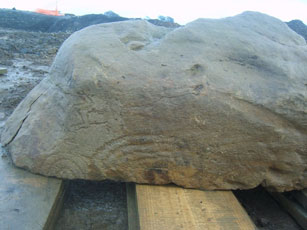|
|
|
Tara Fianna |
|
||
The grave
|
![]()
The Valley has other historical significance, not least as the graveyard of the Fianna. The last battle of the Fianna was fought in the ‘Valley of the Gabair’. This has been understood to mean ‘the valley of the goat’, but no one to date has identified its exact location until now. It was also in this Valley that Oscar, son of Oisin, son of Finn, drew his last breath; and for him Finn cried tears of sorrow. The only other time Finn cried was when Bran, his faithful hound and other world voyager, died. Finn and his band of warriors were at Tara in the reign of Cormac mac Art and link the King Cycle of Tales with the Finnian Cycle. It is highly probable that the warriors of the Fianna are buried in the horseshoe-shaped mound that is today called Rath Lūg. (Lūg was the father of Cū Chulainn.) We have descriptions of the graves of the Fianna and a careful archaeological investigation could indicate the truth or otherwise of this thesis. The place names are also linked and so is the death of Ulster’s greatest hero, Cu Chulainn. Both the head (the cauldron of wisdom) and the sword hand of Cu Chulainn are buried at Tara. Thus we have the four cycles of Irish history are interlinked in this lovely valley in the Royal City of Meath. The whole complex of Tara, Skryne and the Valley of the White Mare is surrounded by a series of defensive embankments and huge ring forts. This Royal city is uniquely rich and varied, forming a historical tapestry of many axes. It should seem insane to disturb this sacred landscape, let alone to disembowel it with a double tolled motorway. |
| more from Druidschool HERE |
![]()
|
![]()
![]()
![]()

![]()
Tara Tara Tara
Please contact for any questions: anitagreg@gmail.com
|
Colm Toibin |
|
|
|
|

![]()
![]()
![]()













